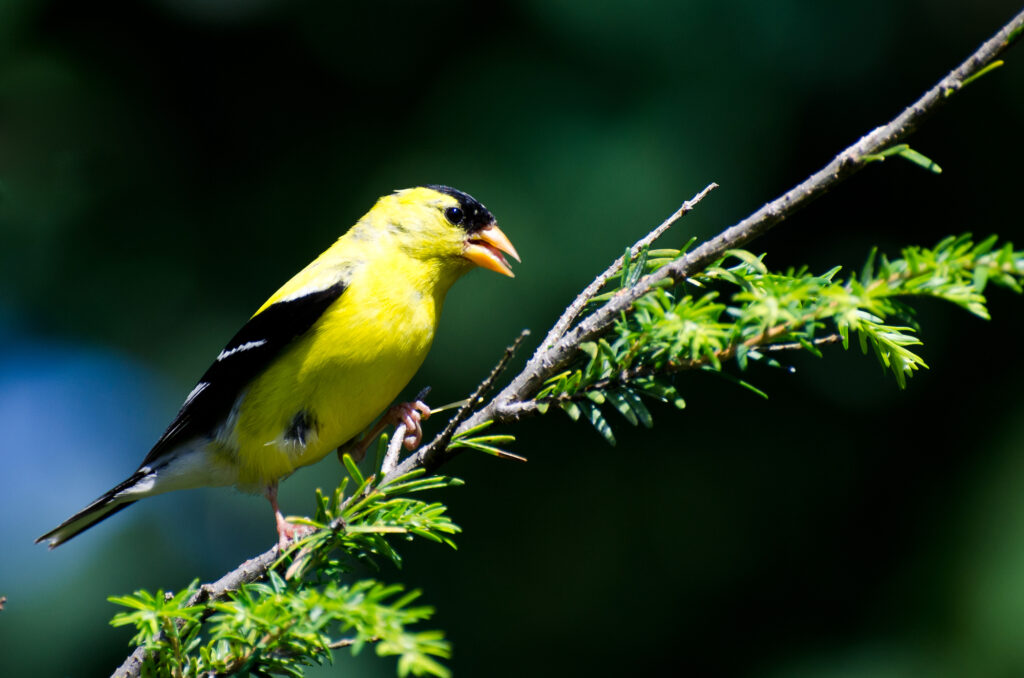Louisiana is located rather centrally at the southern edge of the United States. Its coastline spreads along the Gulf of Mexico, and the Mississippi river crosses its eastern side. It’s not surprising then to see vast areas of marshes, grasslands, and coastal prairie throughout the state.
Plenty of the wilderness in Louisiana was replaced by farming and development, but the remaining parts are home to 40 species of mammals including black bears, about a million alligators, and 404 bird species.
The following is a list of the 25 most interesting birds in Louisiana. Let’s see how many you can identify.
Red Birds in Louisiana
Scarlet Tanager
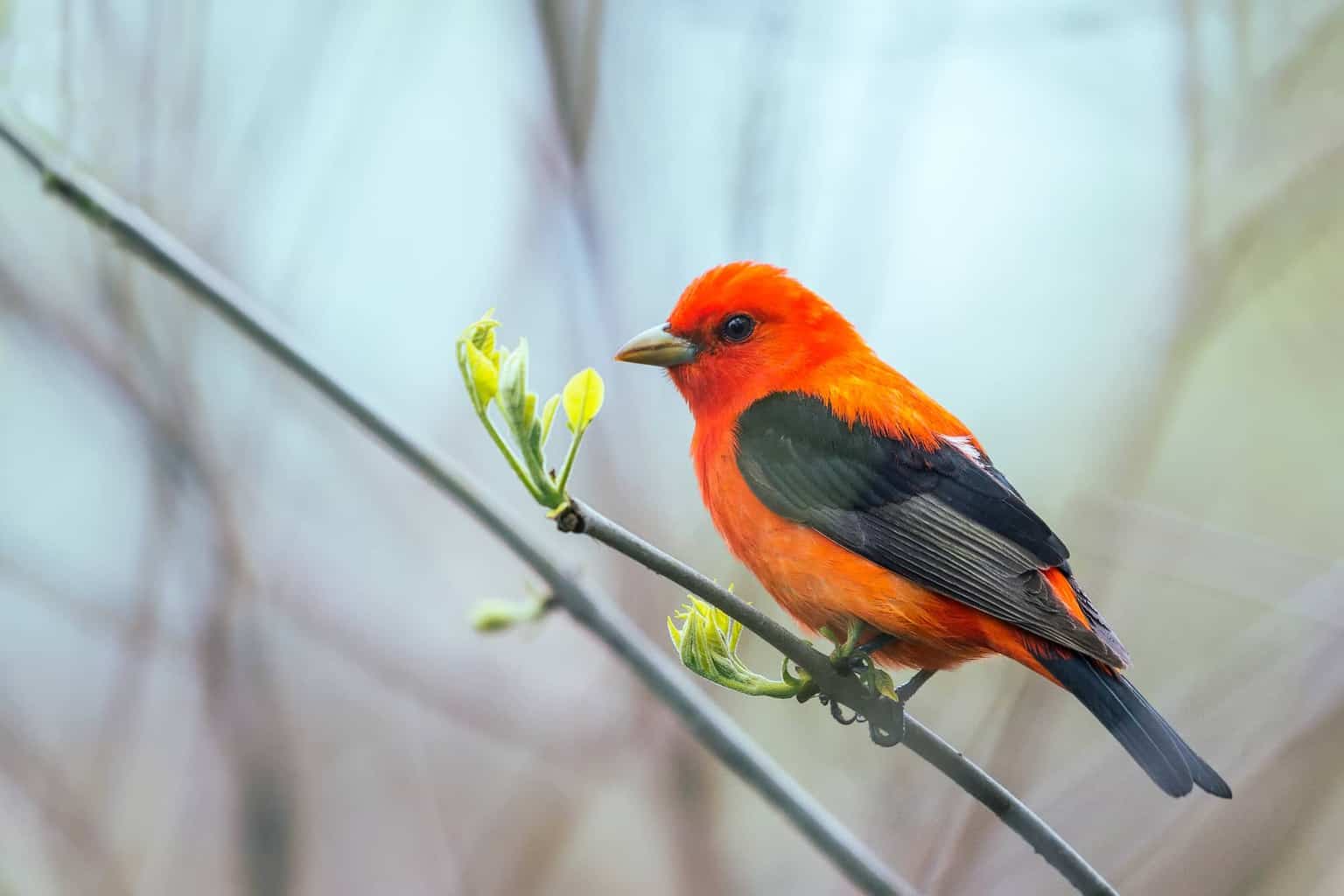
- Scientific Name: Piranga olivacea
- Length: 6.3-6.7 in
- Weight: 0.8-1.3 oz
- Wingspan: 9.8-11.4 in
Additional Information:
The Scarlet Tanagers are quite picturesque with their bright red colors that contrast with their black wings and beady eyes. The females of the species are starkly different though, and most have a pale yellow coloring.
Interestingly, the males often lose their bright feathers after the breeding season, and as they molt, they become quite similar to the pale-colored females!
These birds might not be too easy to find, as they often take up residence within the branches of deciduous trees. If you happen to pass through a forest, you’d probably hear its distinctive song. Take a good look at the canopy, and there it would be.
Northern Cardinal

- Scientific Name: Cardinalis cardinalis
- Length: 8.3-9.1 in
- Weight: 1.5-1.7 oz
- Wingspan: 9.8-12.2 in
Additional Information:
Male Northern Cardinals are characterized by their flaming red color and majestic crest. If you see them up close, you’d also notice a black patch around thick bills that also extends slightly down their throats.
The females are much less flashy, as the red feathers only adorn their wings and tails, with the slightest hint on their crests. They’re also somewhat plumper than the males.
These birds aren’t migratory, and they don’t have the habit of molting out of their feathers. They’re also quite sociable, so you could enjoy their presence at your feeder all year round.
Pyrrhuloxia
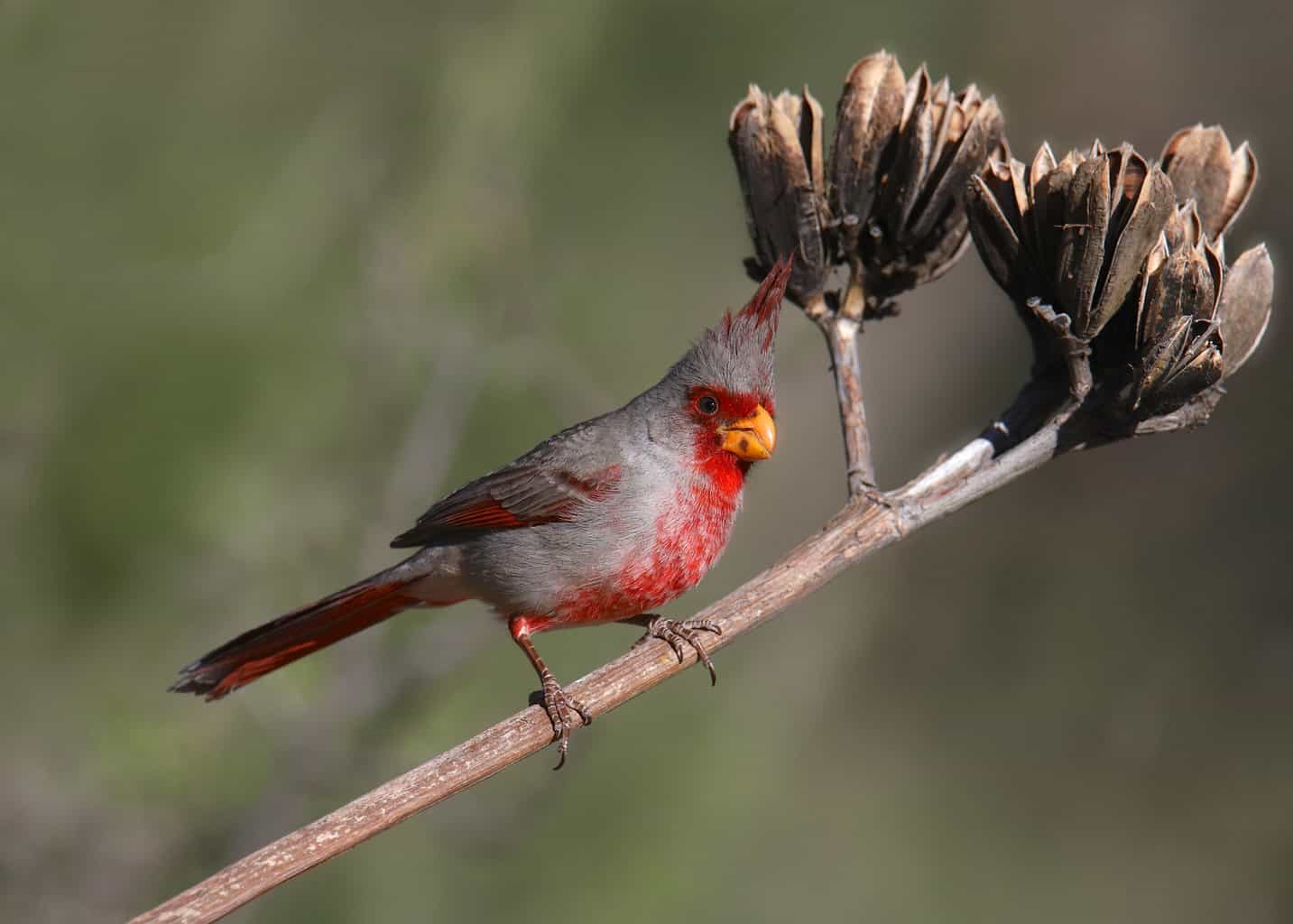
- Scientific Name: Cardinalis sinuatus
- Length: 8.3 in
- Weight: 0.8-1.5 oz
- Wingspan: 11.25 in
Additional Information:
A Pyrrhuloxia could easily be confused with a female Northern Cardinal, as it only has red highlights on its feathers, rather than a full crimson cover. It’s also characterized by red plumage in addition to a red mask that surrounds a bright yellow thick bill.
The females are even paler than their male counterparts, but they share the same general appearance. Both genders are slightly larger than a sparrow.
These birds come in heavily populated flocks that could amount to thousands of birds. They mostly eat insects, and that’s also where they get most of the hydration they need. They’re desert dwellers, and you’d rarely see them elsewhere.
Red-Headed Woodpecker
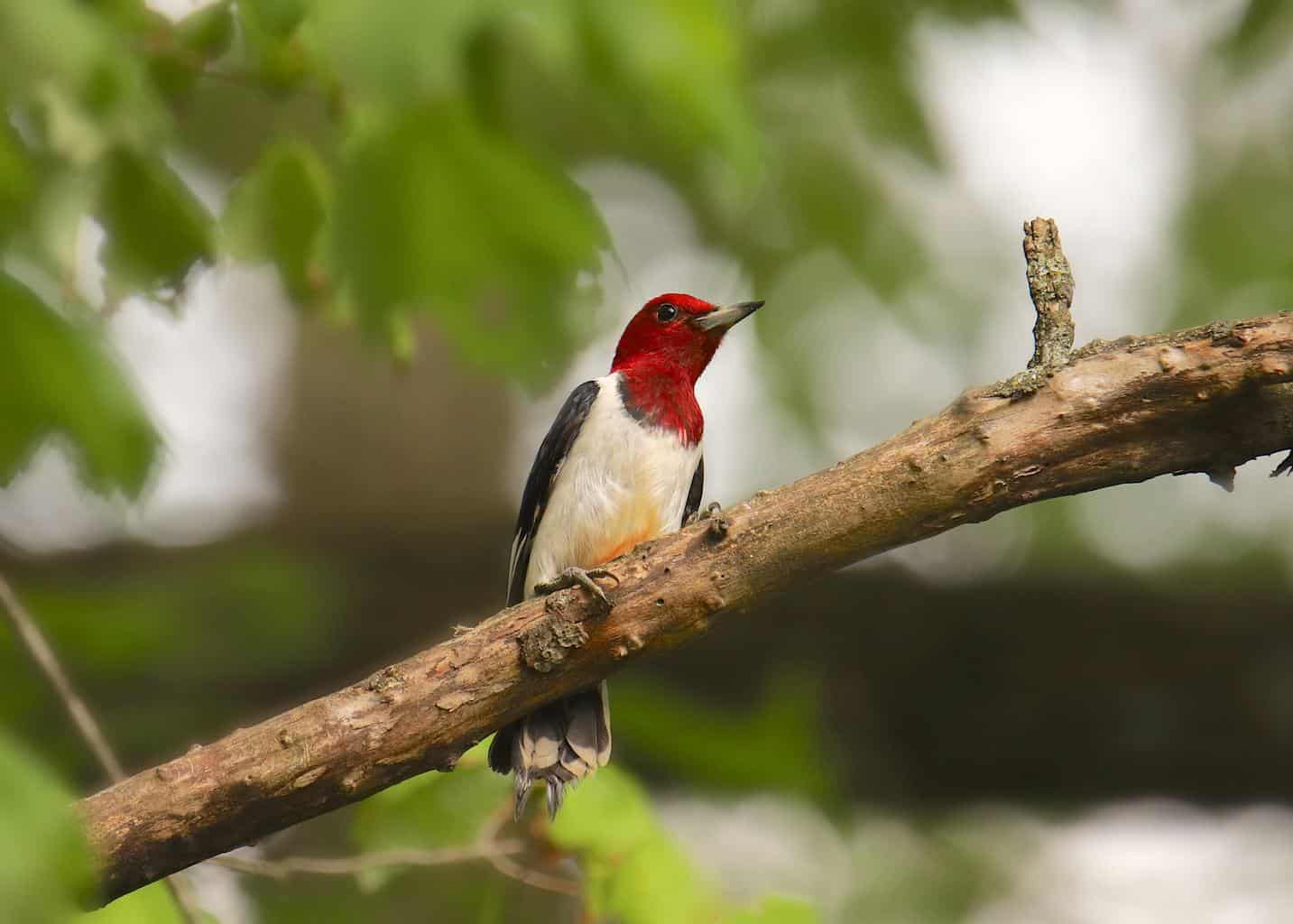
- Scientific Name: Melanerpes erythrocephalus
- Length: 7.5-9.1 in
- Weight: 2.0-3.2 oz
- Wingspan: 16.5 in
Additional Information:
The Red-headed Woodpecker is among the easiest to identify among its species. It has a bright red head that’s slightly large compared to its tiny stature. And the rest of its body has contrasting snow-white and blue-black feathers.
Red-headed Woodpeckers are intelligent birds that know how to store food inside cavities and cover it up so that other animals can’t find it. They’re also quite territorial, and wouldn’t hesitate to break other birds’ eggs if they feel that they intruded on their personal space.
These birds are so riveting to watch, to the point that the 1700s ornithologist, Alexander Wilson, couldn’t stop observing them. And he remained deeply interested in birdwatching ever since.
Painted Redstart
- Scientific Name: Myioborus pictus
- Length: 5.1-5.9 in
- Weight: 0.3-0.4 oz
- Wingspan: 8.3 in
Additional Information:
An adult Painted Redstart is a well-proportioned, and incredibly cute little bird, with a bright red patch on its belly.
The juveniles aren’t such colorful birds, as they’re mostly gray. But they share a few traits with the grown-ups, like the white patch on their wings and the white crescent under their beady eyes.
These birds feed on insects mainly, and they have quite peculiar methods of foraging. They spread their wings and seem to take the insects by surprise, then they go after them, and gobble up their scared prey.
Blue Birds in Louisiana
Blue Bunting
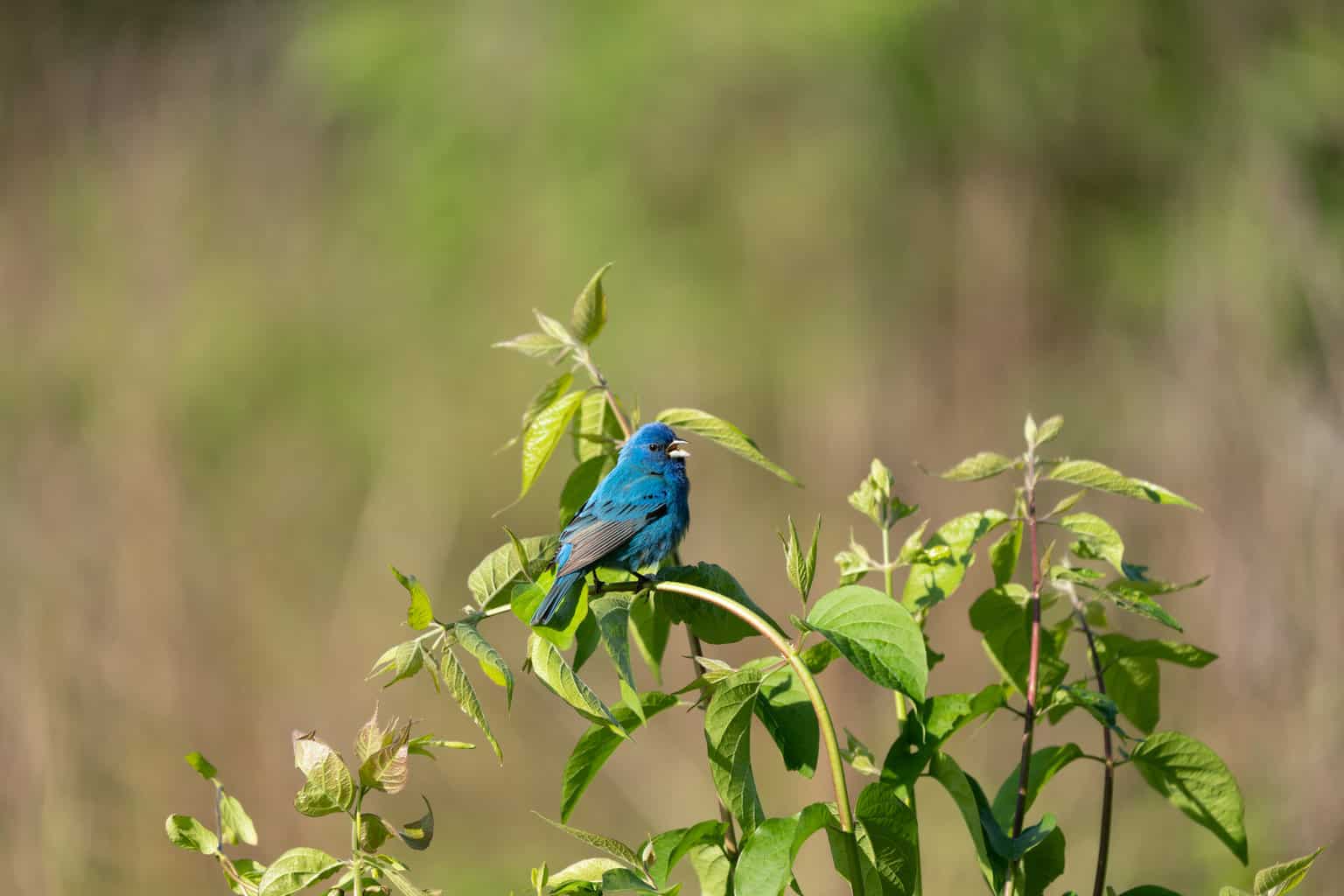
- Scientific Name: Cyanocompsa parellina
- Length: 5.1-5.5 in
- Weight: Males weigh 0.39-0.85 oz and females 0.35-0.74 oz
- Wingspan: 7.5-8.7 in
Additional Information:
The Blue Bunting is a member of the Cardinal Grosbeaks family, which is characterized by its deep blue colors and thick curved bills. The feathers often have various shades of blue and hints of black around the bird’s bill and wings.
They’re abundant in the South around Mexico, Honduras, Belize, and El Salvador. It’s an occasional visitor to Louisiana and Texas, and that’s why birdwatchers get ecstatic when they spot one.
These birds like foraging in low vegetation, and you can tell they’re around from their distinctive song and rather tinny call.
Cerulean Warbler
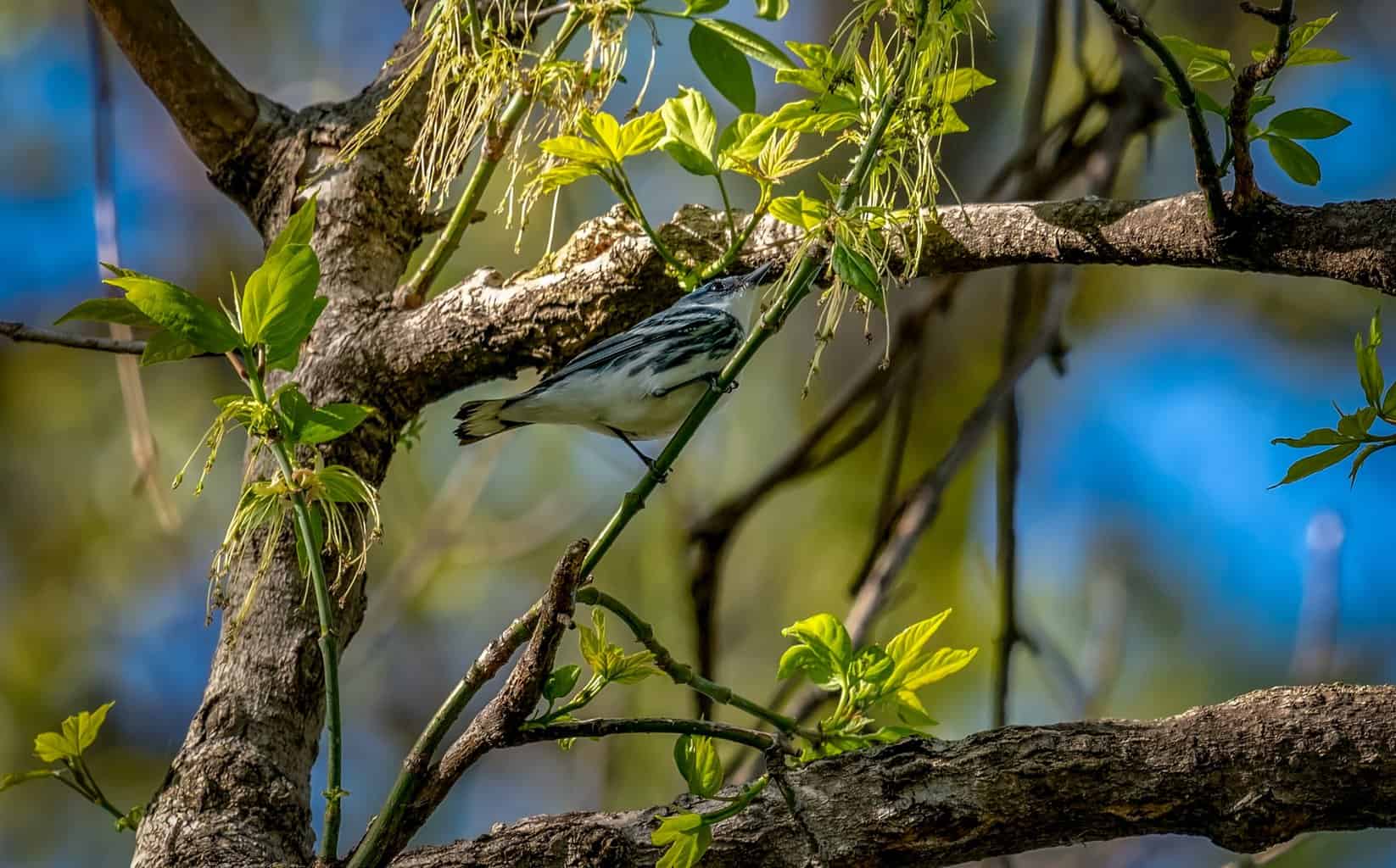
- Scientific Name: Setophaga cerulea
- Length: 4.3 in
- Weight: 0.3-0.3 oz
- Wingspan: 7.9 in
Additional Information:
The male Cerulean Warbler has a beautiful sky-blue color that’s streaked with a few white and black patterns. The females have a light-green tint and more grey on their bodies.
A Cerulean Warbler couple usually stays together throughout the mating season. They forage insects together at the tops of canopies. And if an intruder dares to approach, they put up a good fight.
These birds are quite rare, as their populations declined steeply from 1970 to 2014 due to the loss of suitable habitat. With a reduction of 72%; the International Union for the Conservation of Nature (IUCN) labels them as ‘vulnerable’.
Mountain Bluebird
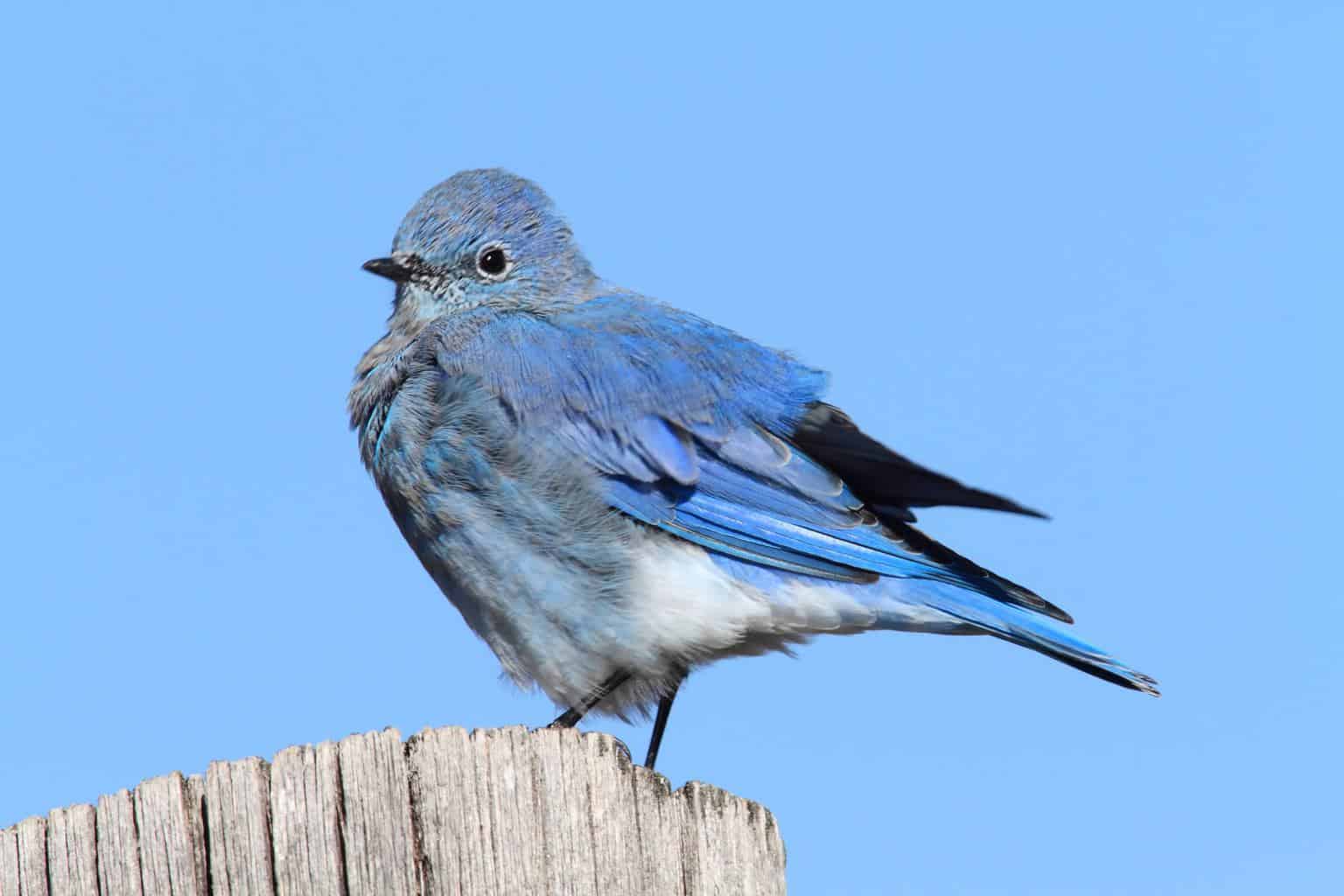
- Scientific Name: Sialia currucoides
- Length: 6.1-7.1 in
- Weight: 0.85-1.31 oz
- Wingspan: 11.0-14.2 in
Additional Information:
Mountain Bluebirds are small stocky thrushes, with the males covered in blue feathers and the females in greyish-brown. They’re quite similar to Eastern and Western Bluebirds, except for the fact they have no rust-colored feathers at all.
Foraging is another trait that sets Mountain birds apart from similar small birds. They’re in the habit of hovering around their insects or flying low, then plunging down and pouncing on them.
You might not be able to see this maneuver in winter though, as their diet shifts to juniper berries when the insects become scarce.
Blue Jay
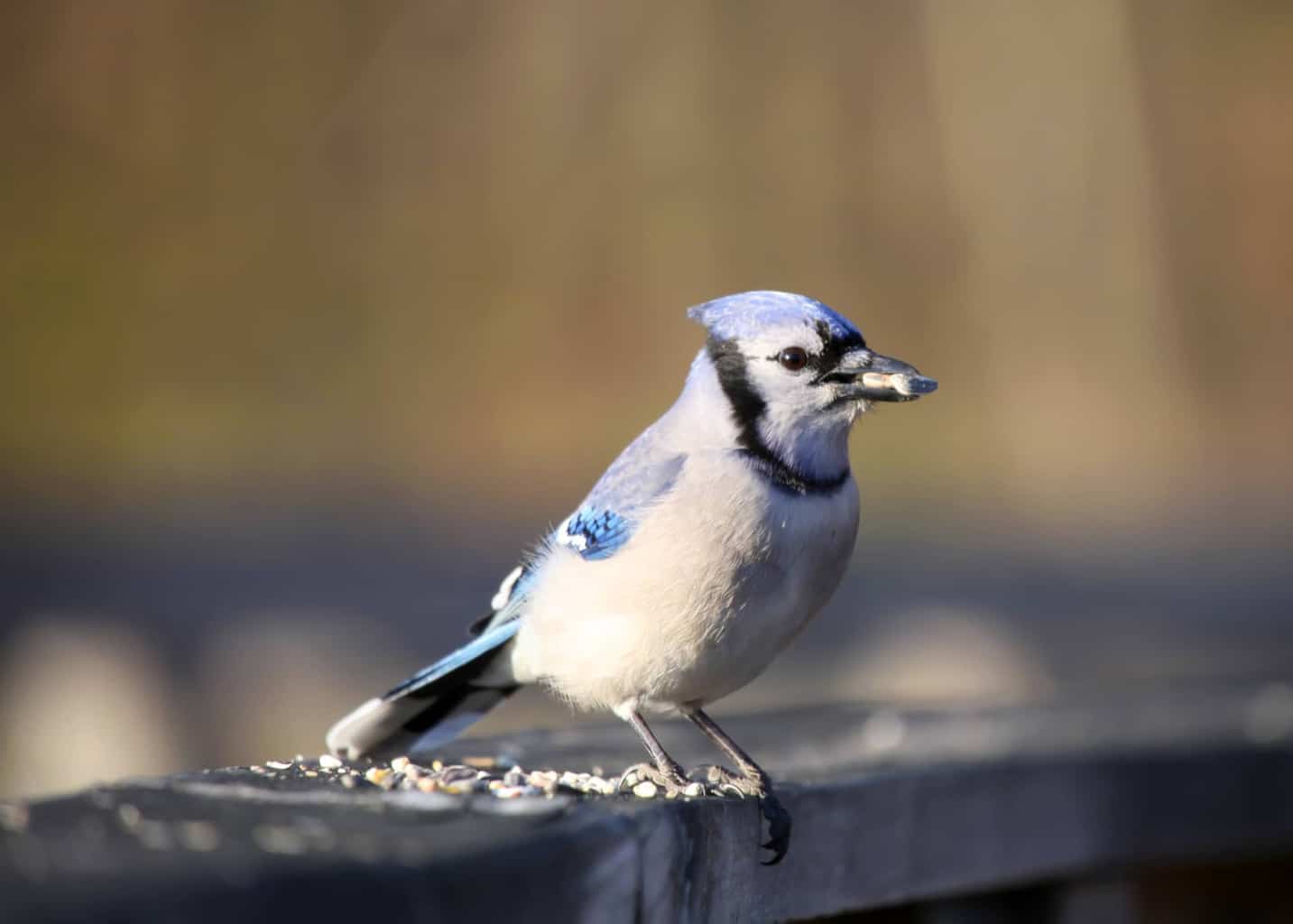
- Scientific Name: Cyanocitta cristata
- Length: 9-12 in
- Weight: 2.5-3.5 oz
- Wingspan: 13-17 in
Additional Information:
Blue Jays have stunning good looks, and if you come across one, make sure to take plenty of memorable photos.
They have various shades of blue on their bodies, except for their bellies, which are often pale gray. In addition, Blue Jays have white and black markings on their wings and tails that are pretty hard to miss.
The prominent blue crest and black contouring around it are also among the characteristics of these intriguing birds.
You can entice blue jays to visit your backyard by offering them their favorite foods. They love suet, peanuts, and sunflower seeds. It would be best to offer these foods on a tray attached to a post, rather than in regular bird or suet feeders.
Blue Jays are migratory birds, but they don’t have a system or pattern that anyone could understand. They might migrate several seasons in a row, then one winter, they decide to skip traveling altogether. They could also go south one year, then north the next. No one knows why!
Barn Swallow

- Scientific Name: Hirundo rustica
- Length: 5.9-7.5 in
- Weight: 0.6-0.7 oz
- Wingspan: 11.4-12.6 in
Additional Information:
Barn Swallows are among nature’s best works of art when it comes to their artistic coloring and well-studied curves. They have a feathery coat of steel-blue that contrasts with tawny-beige and copper highlights.
Like the rest of the swallows, you must see Barn Swallows spreading their wings in full flight to appreciate their unique shapes. Particularly, the long pointed wings and forking fan-shaped tail.
These streamlined qualities help swallows to execute tight maneuvers and air acrobatics, which they often use while foraging. They feed on insects mainly, but you can invite them to eat ground eggshells or oyster shells at your backyard feeder.
These acrobatic birds usually take residence in open grasslands, meadows, or parks. They can also be seen around the edges of roadways, while some like to live near coastlines and ponds.
Green Birds in Louisiana
Tennessee Warbler
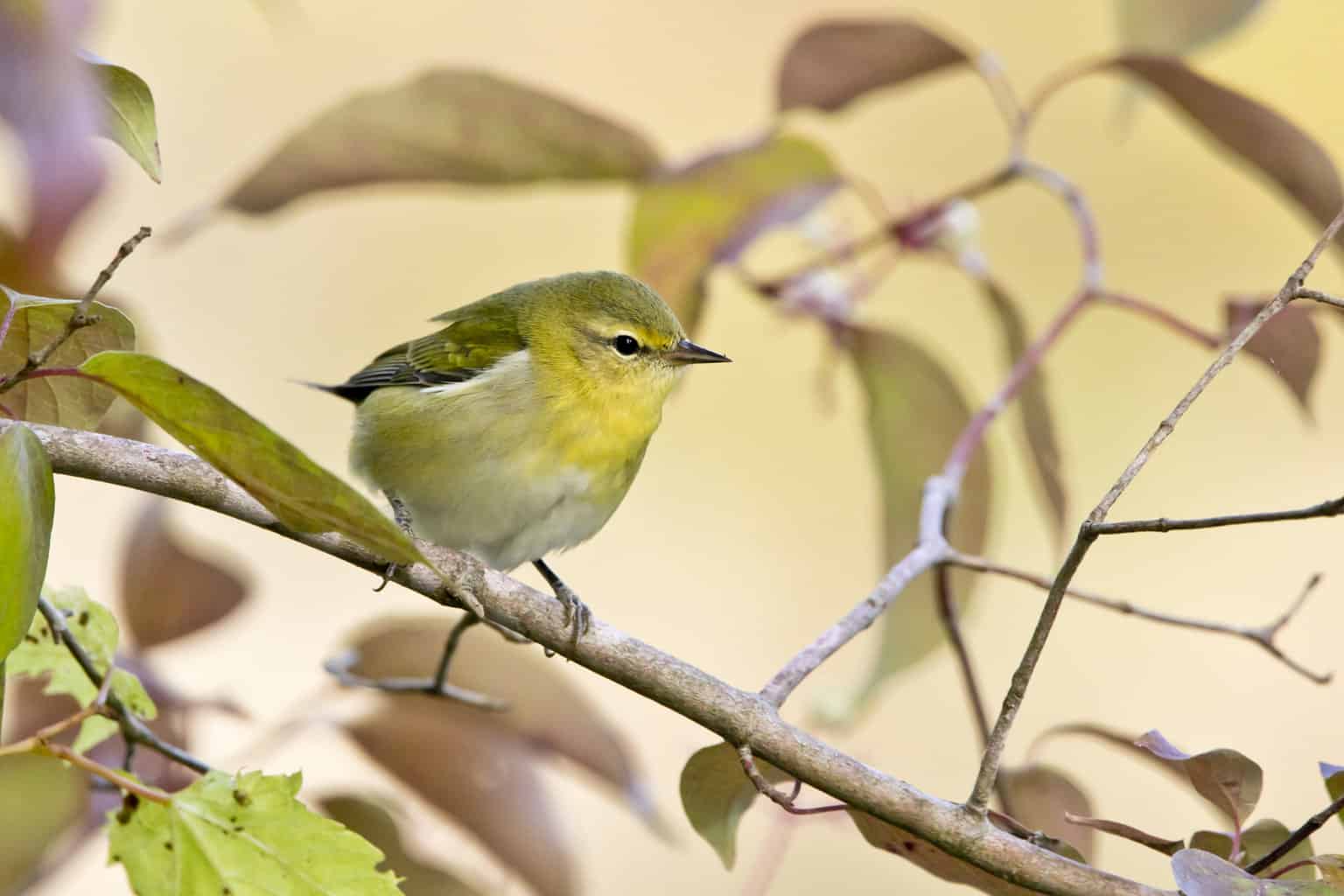
- Scientific Name: Leiothlypis peregrina
- Length: 3.9-5.1 in
- Weight: 0.3-0.3 oz
- Wingspan: 7.5-7.9 in
Additional Information:
Tennessee Warblers are small birds with large heads and plump bellies. The males have light olive-green backs while the females have yellow coloring.
These birds are fond of eating caterpillars, but they wouldn’t mind stealing nectar from the base of flowers. This way, they get the juice without helping with flower pollination! You’ll find them at the treetops of open forests, mostly hopping on the thin branches.
Tennessee Warblers are migratory birds, thus, the best time to spot them is between the months of May and September.
Mallard

- Scientific Name: Anas platyrhynchos
- Length: 19.7-25.6 in
- Weight: 35.3-45.9 oz
- Wingspan: 32.3-37.4 in
Additional Information:
Mallards are quite abundant in North America and Eurasia, so the chances are you’ve seen at least one floating by in a pond. They’re also quite easy to identify, with the males having metallic-green heads, maroon sides, and black tails.
The females are rather demure in their coloring and temperament, and they look quite similar to the domestic ducks on farms.
Mallards aren’t big on diving, and you’d mostly see them dipping their heads in the water looking for a nice plant or aquatic creature to eat. They’re formidable fliers though and are known to reach 55 miles per hour easily.
Anhinga
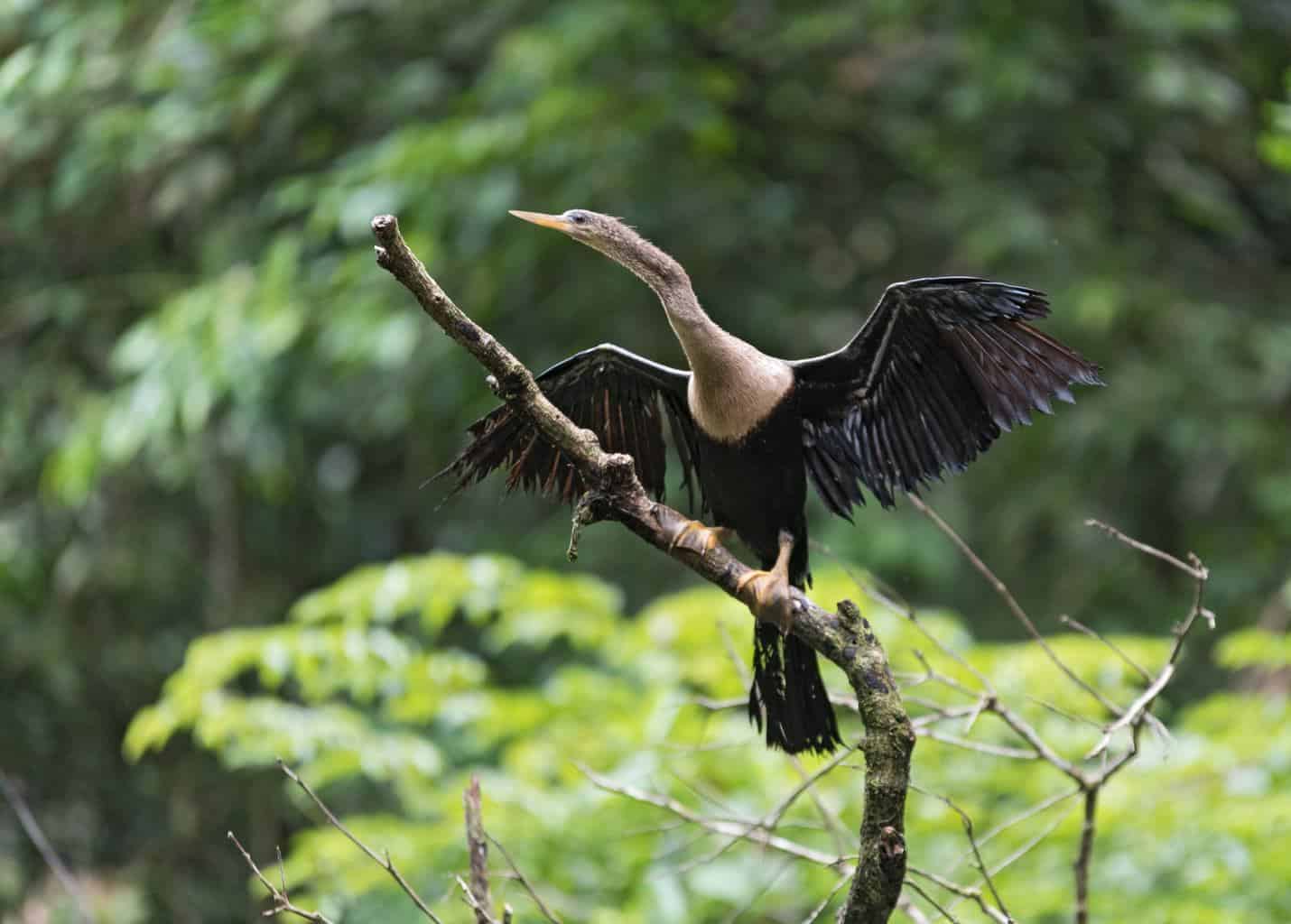
- Scientific Name: Anhinga anhinga
- Length: 30-37 in
- Weight: 2.3-3.0 lb
- Wingspan: 3.7 ft
Additional Information:
The Anhinga is a large waterbird that also rides the air like a pro. The males of the species are mostly black, with white patterns on their backs and wings, while the females are mostly beige with dark bellies.
They both share a long snake-like neck shaped like the letter ‘S’ and a bill that looks like a dagger. Their tails spread like fans in a manner that’s quite similar to turkeys.
When they take to the sky, the Anhingas look like a cross, as they spread their wings full-width and extend their necks forward. They glide over the thermals pretty much like eagles and other mighty predators. They have very different lifestyles though.
Anhingas feed mainly on fish, and they dive underwater looking for it. Once they’re done, they often find a brand and perch on it. They spread their wings and tails fully to dry out, then resume their daily activities.
Hooded Warbler
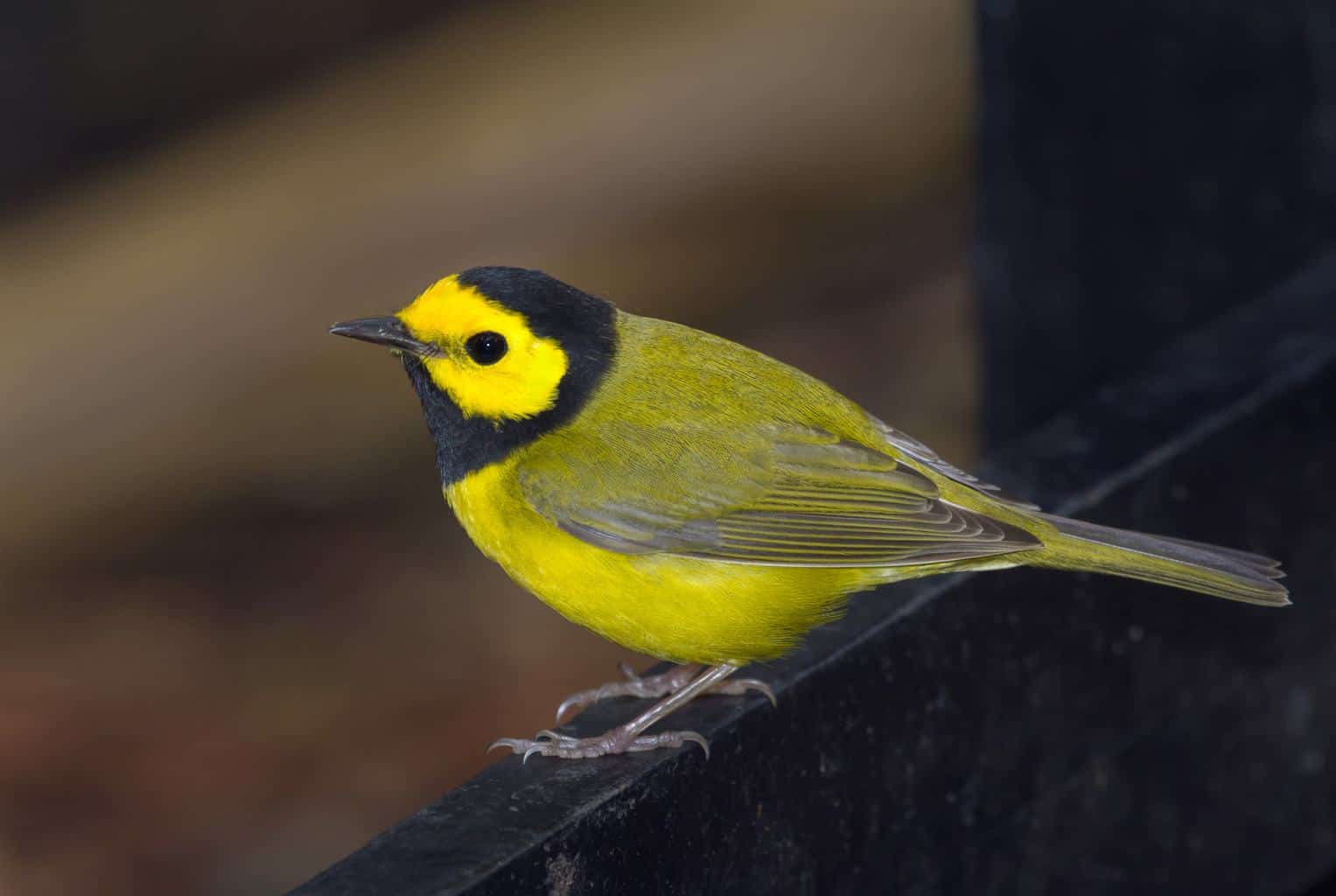
- Scientific Name: Setophaga citrina
- Length: 5.1 in
- Weight: 0.32-0.42 oz
- Wingspan: 6.9 in
Additional Information:
The male Hooded Warblers are olive-colored with a yellow face and belly. Their trademark is the black hood that surrounds their faces and extends a little down their throats.
The females have more yellow coloring and lack the hood entirely. They’re slightly smaller than the males, and might be confused with Wilson’s or Kentucky Warblers.
You can find these little birds hiding in the vegetation. Mostly hopping on the lower branches, and maybe catching a few insects for lunch.
Hooded Warblers aren’t too keen on visiting backyard feeders. But if you want to attract them, you can plant a few trees and shrubs of their linking. They’d probably accept the invitation then.
Orange Birds in Louisiana
Western Tanager
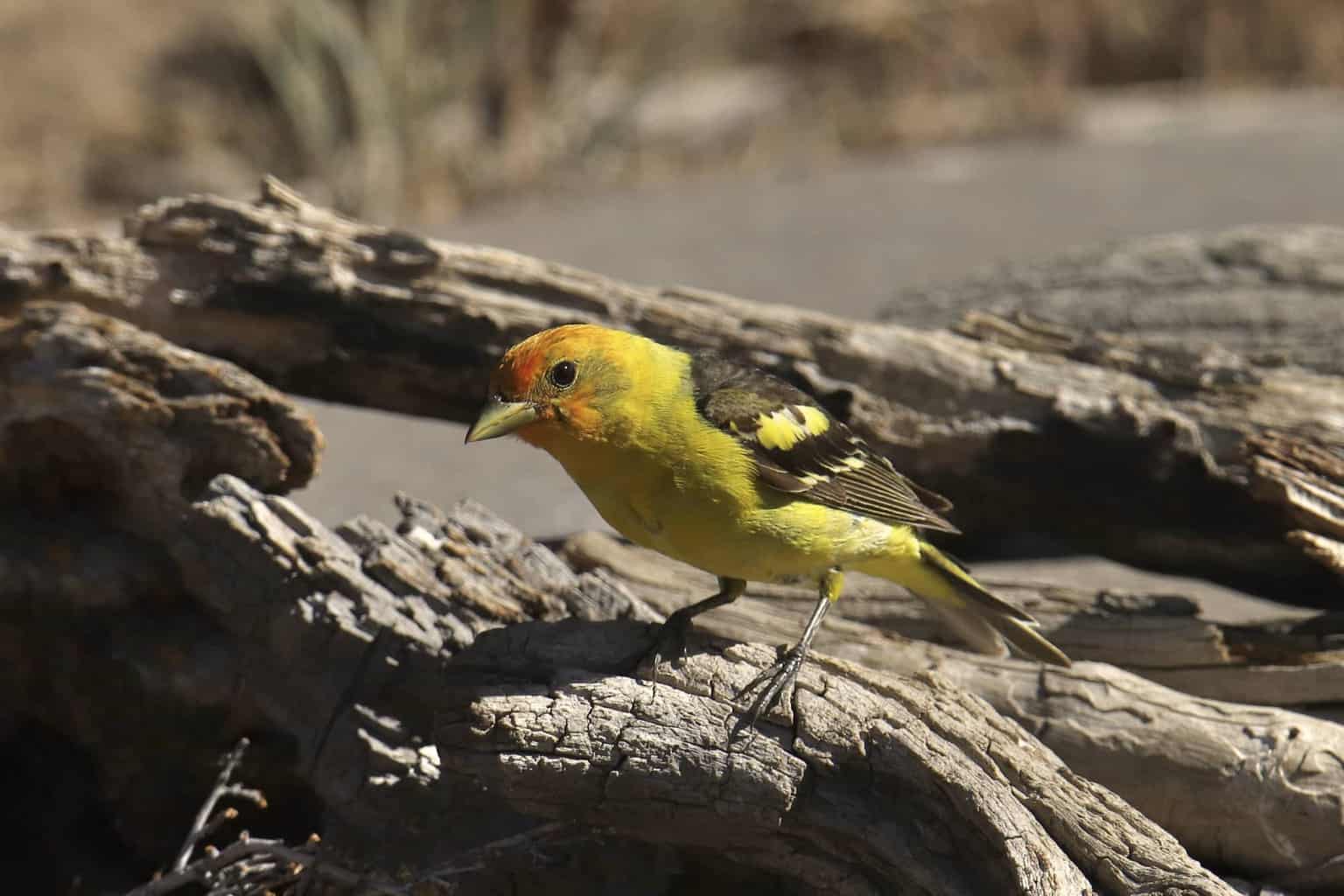
- Scientific Name: Piranga ludoviciana
- Length: 6.3-7.5 in
- Weight: 0.8-1.3 oz
- Wingspan: 11.5 in
Additional Information:
The adult male Western Tanager is characterized by a bright orange head, yellow body, black patterned wings, and a thick bill. The birds of this species are larger and stockier than warblers, but generally smaller than a Robin.
The females are less colorful and smaller in size. They also have different markings on their wings. Actually, it might be easier to spot the male of the couple, and then identify his mate.
These birds feed mainly on insects, and they usually forage for them on the branches they inhabit. Occasionally they catch an insect midair if the prey seems too appetizing. They vary the menu to fruits and berries during the winter season when the insects are in short supply.
Black-Headed Grosbeak
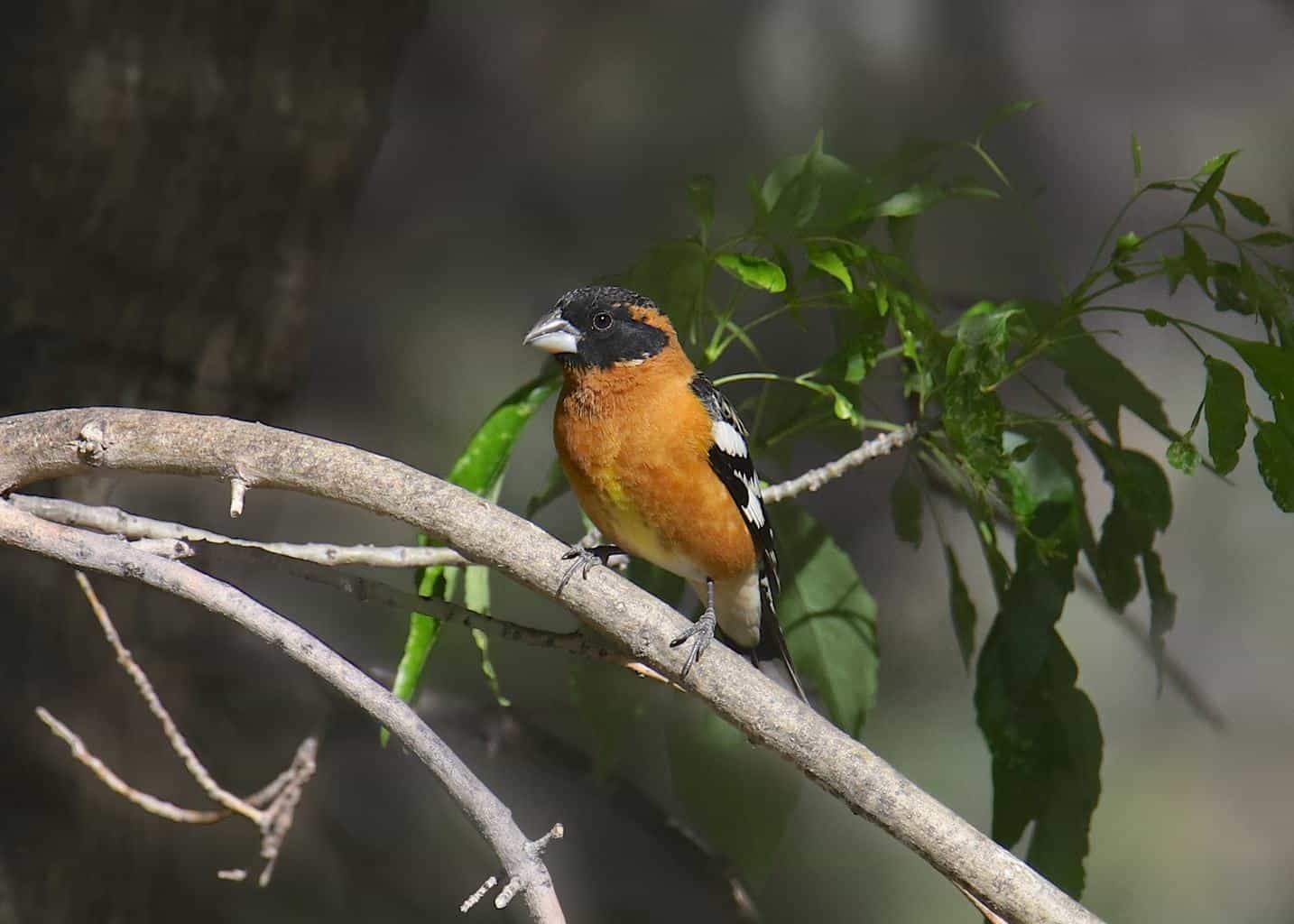
- Scientific Name: Pheucticus melanocephalus
- Length: 7.1-7.5 in
- Weight: 1.2-1.7 oz
- Wingspan: 12.6 in
Additional Information:
Male Black-headed Grosbeaks have bright orange bodies with contrasting black heads and wings. They’re not difficult to identify at all, and their flashy colors often show through tree branches.
The females are a little less conspicuous, but they share the same thick curved bill as the males. They’re both medium-sized birds almost as big as Robins.
Black-headed Grosbeaks are songbirds that fill the air with a musical song. They’re open to visiting backyard bird feeders if you offer them their favorite sunflower seeds, and they’ll pay you back with their cheerful demeanor.
These birds are quite domestic, with both the male and female sharing the nesting chores. This includes sitting on the eggs, taking turns feeding the hatchlings, and fending off intruders.
American Robin

- Scientific Name: Turdus migratorius
- Length: 7.9-11.0 in
- Weight: 2.7-3.0 oz
- Wingspan: 12.2-15.8 in
Additional Information:
The adult American Robin is quite easy to identify, with its orange belly, grey back, and yellow bill. It’s a medium-sized bird that you’ll see in various places.
American Robins are rather sociable so you can spot them hopping around golf courses, parks, gardens, and yards. They also take residence in pine forests, tundra, pastures, woodlands, and shrubberies.
Yellow Birds in Louisiana
Dickcissel
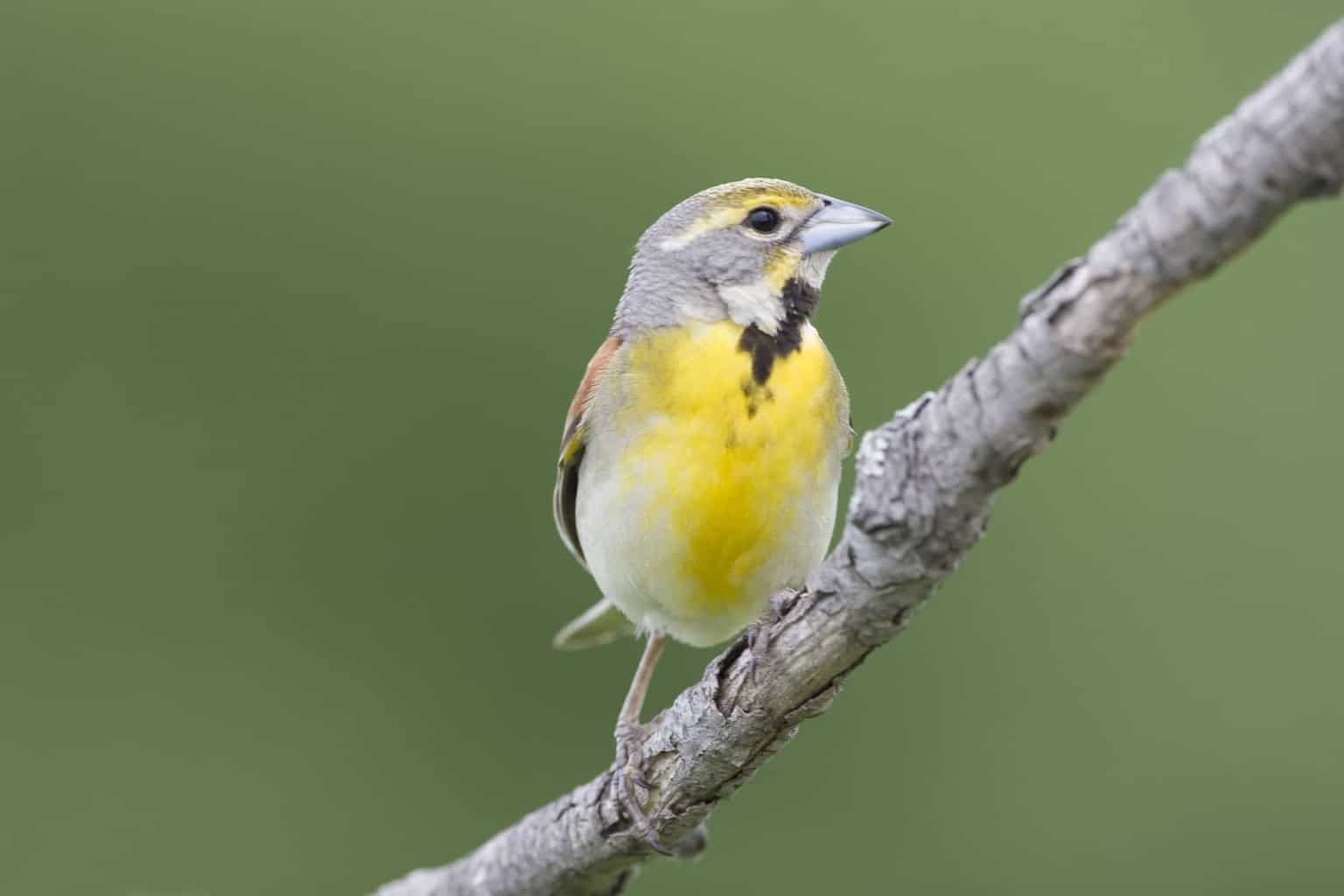
- Scientific Name: Spiza americana
- Length: 5.5-6.3 in
- Weight: 0.9-1.4 oz
- Wingspan: 9.8-10.2 in
Additional Information:
The Dickcissel is a tiny bird that looks a lot like a sparrow. It has a thicker bill though, and different color patterns.
The males and females both have yellow bellies, plus yellow highlights on their throats and around their eyes. The males have an extra identifier, which is a black ‘V’ on their chests.
Dickcissels often take residence in tall grasslands, but you could catch a few of them hovering around roadsides. They could also live in hayfields, prairies, and overgrown pastures.
Common Yellowthroat
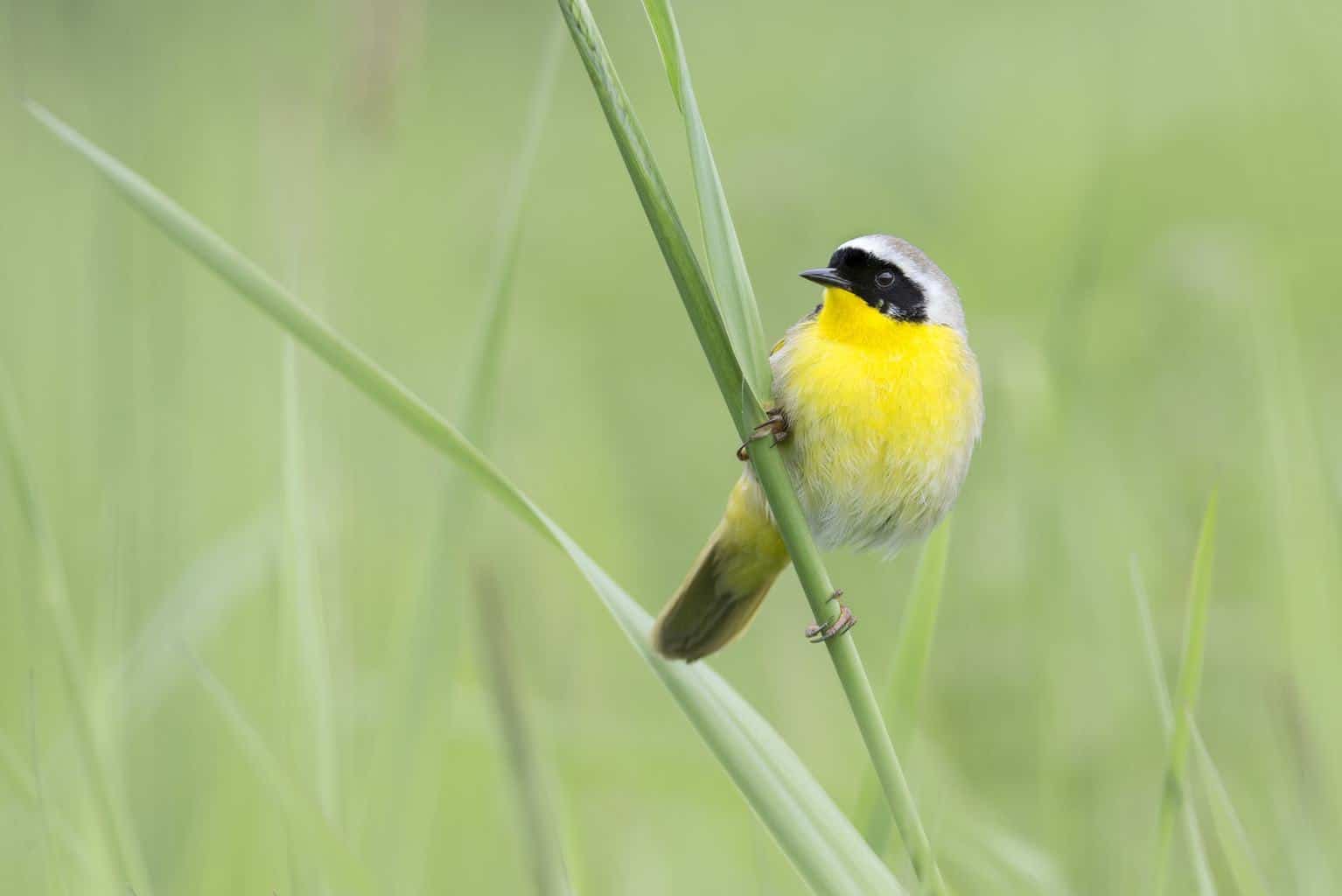
- Scientific Name: Geothlypis trichas
- Length: 4.3-5.1 in
- Weight: 0.3-0.3 oz
- Wingspan: 5.9-7.5 in
Additional Information:
The Common Yellowthroat, which is often nicknamed the “yellow bandit”, is a New World warbler. Its telling characteristic is its yellow chest and the black ‘bandana’ mark around its head. The larger the mask, the more virile the bird!
These songbirds are quite small, and they favor dense vegetation over open areas. You could also spot them around wet areas.
Magnolia Warbler
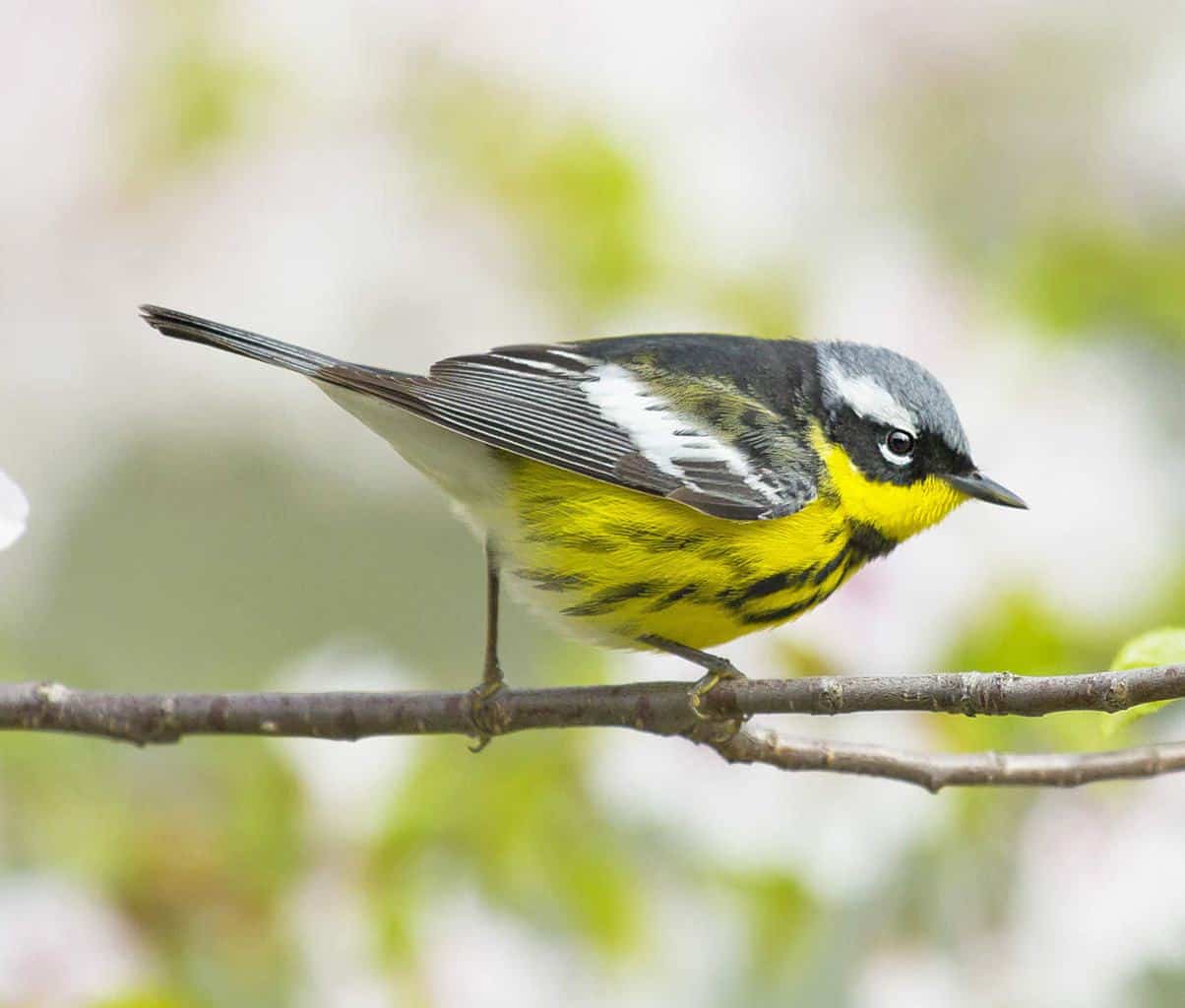
- Scientific Name: Setophaga magnolia
- Length: 4.3-5.1 in
- Weight: 0.2-0.5 oz
- Wingspan: 6.3-7.9 in
Additional Information:
The adult male Magnolia Warbler is easy to identify, as it has a stark yellow body adorned by various black markings. Specifically, the lines radiating from its throat through its belly down to its tail. Also, the black bandana shape that covers its eyes and half its head.
The females are less colorful and might be mixed up with various other warblers with their yellow and grey coloring.
You can find these birds foraging for insects amidst the thin branches of Boreal forests. Look for them during the spring and fall months, as they often migrate to warmer places before the winter arrives.
American Goldfinch
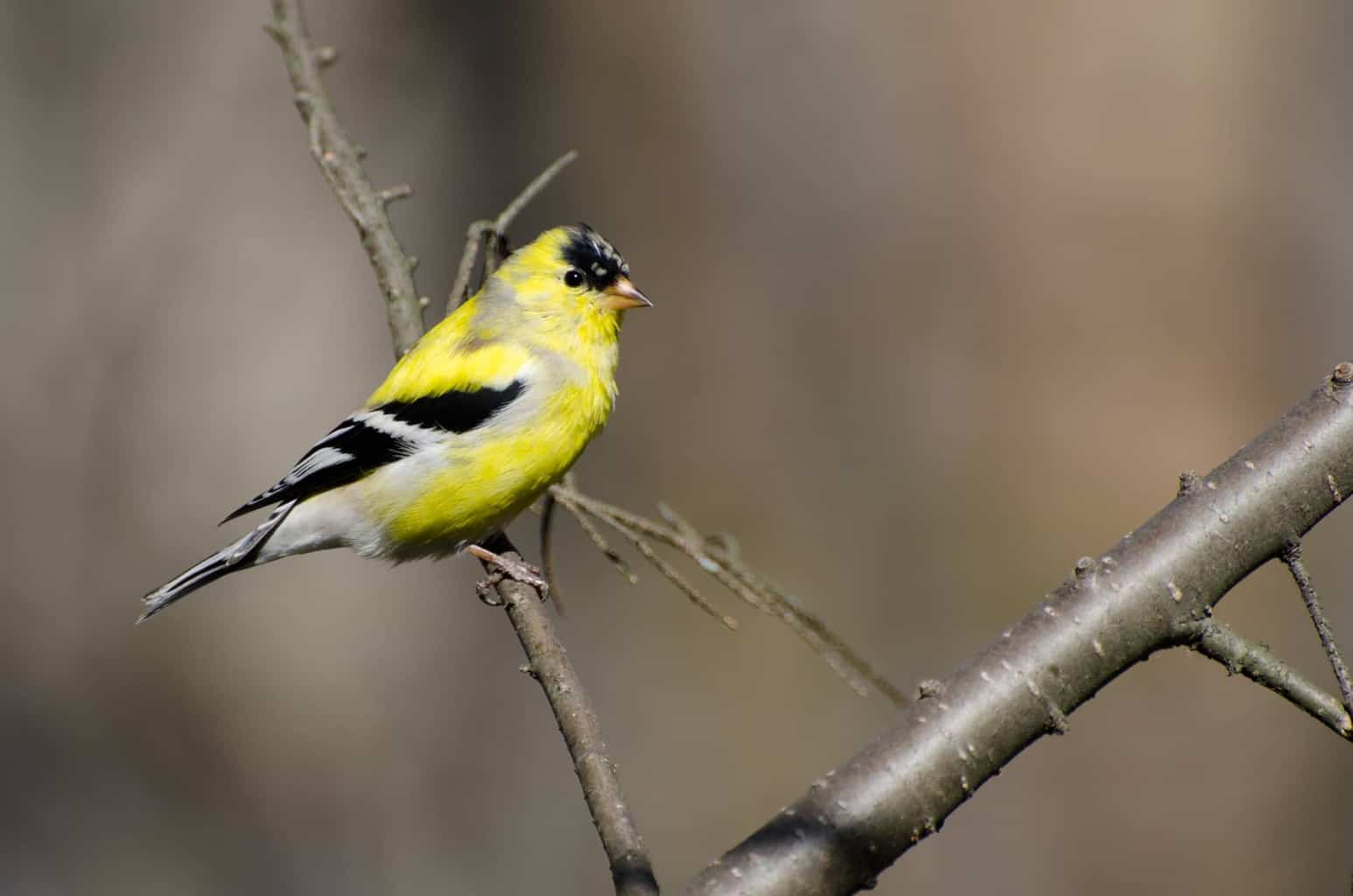
- Scientific Name: Spinus tristis
- Length: 4.3-5.1 in
- Weight: 0.4-0.7 oz
- Wingspan: 7.5-8.7 in
Additional Information:
There’s a world of differences between the breeding and non-breeding male American Goldfinches.
The former has a bright yellow body, black wings, and a black patch on its forehead. While the latter is mostly an uneventful beige, with a few dark markings on its wings. The females are also different, as they have olive-colored backs with pale yellow bodies.
These birds favor weedy areas, so you can look for them in orchards, floodplains, and suitably planted backyards where thistle plants grow.
Other Birds To Watch For in Louisiana
Tufted Titmouse
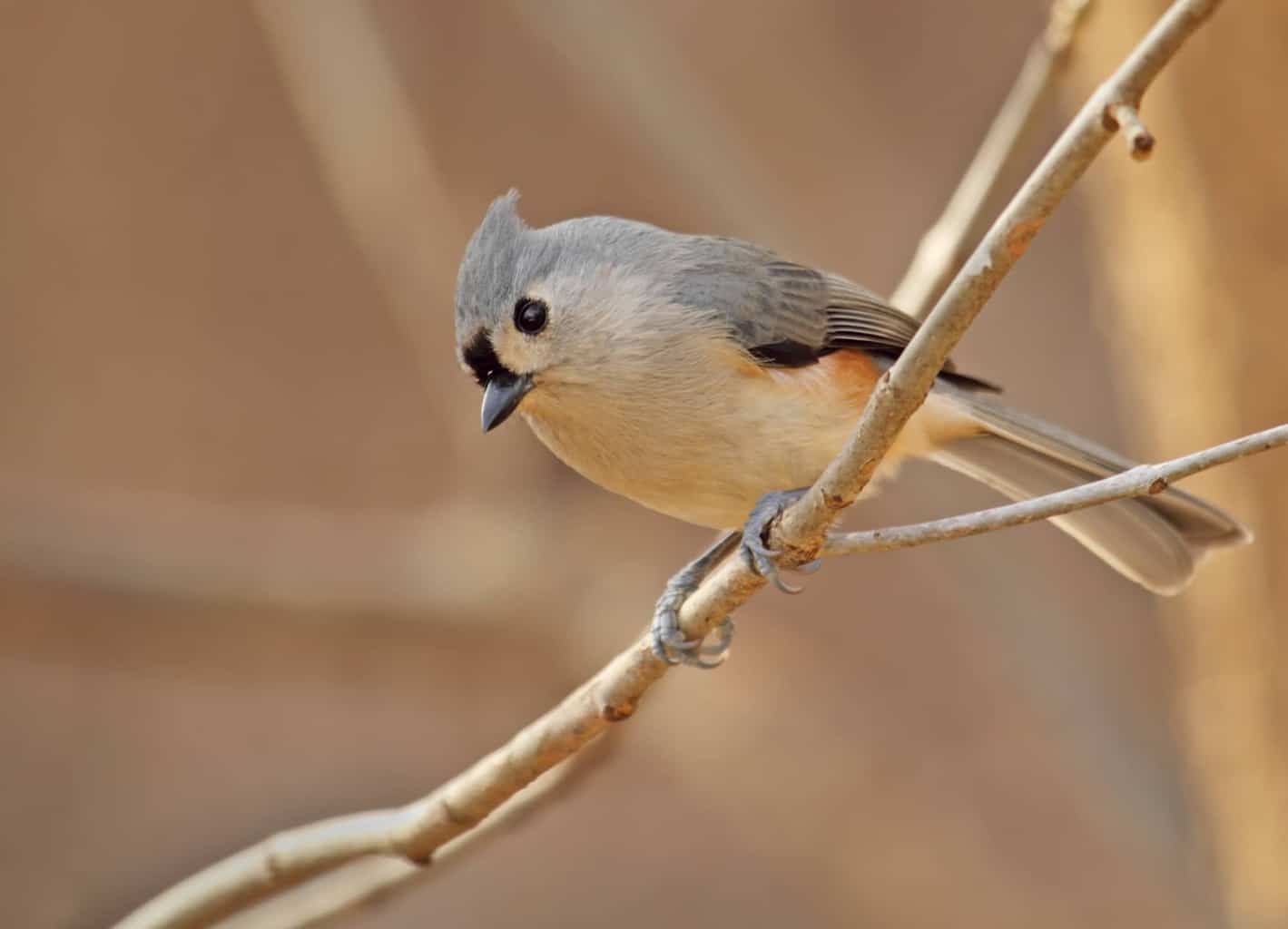
- Scientific Name: Baeolophus bicolor
- Length: 5.5-6.3 in
- Weight: 0.6-0.9 oz
- Wingspan: 7.9-10.2 in
Additional Information:
The tiny Tufted Titmouse is barely the size of a sparrow, but it’s rather plump. And it does bear a slight resemblance to a mouse! This cute little bird is mostly grey with a white underbelly and peach highlights under its wings.
It’s also characterized by a crest, beady black eyes, and a short thin bill. You might find that it looks a lot like a Chickadee, and that’s true. Except that it lacks its black head.
The Tufted Titmouse often resides in evergreen forests, but it wouldn’t nest in the high branches. It could also visit bird feeders, orchards, and parks occasionally.
Greater Roadrunner
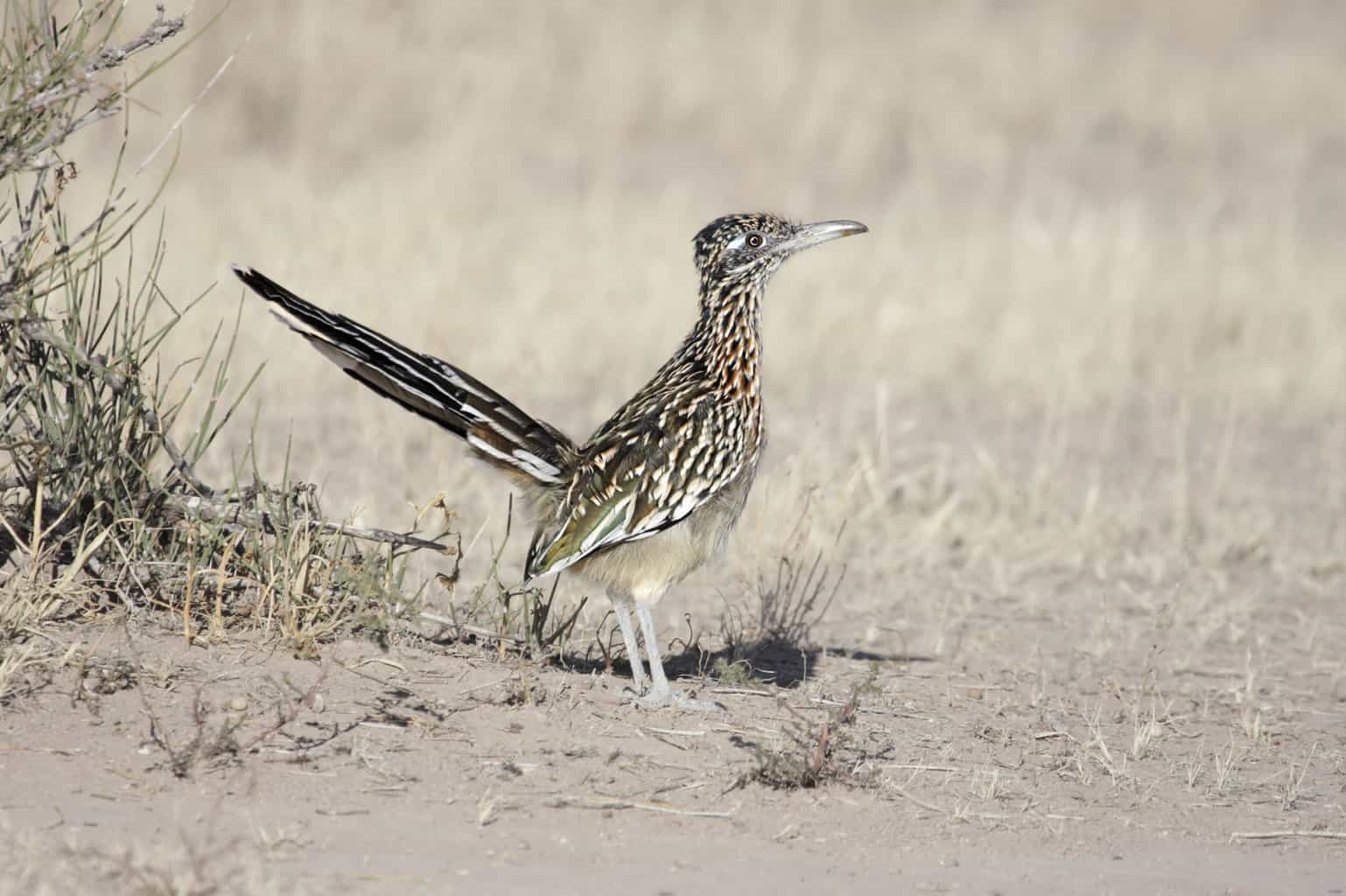
- Scientific Name: Geococcyx californianus
- Length: 20.5-21.3 in
- Weight: 7.8-19.0 oz
- Wingspan: 19.3 in
Additional Information:
The Greater Roadrunner was an inspiration for a cartoon character under the same name. The fictional Roadrunner and the real one share an incredible running speed, an odd posture while speeding, plus a liking for chasing lizards around the dryland all day long!
Besides these hyperactive traits, the Greater Roadrunners also appreciate rest, and you can see them perched on telephone wires, fences, or on a warm rock.
Anna’s Hummingbird
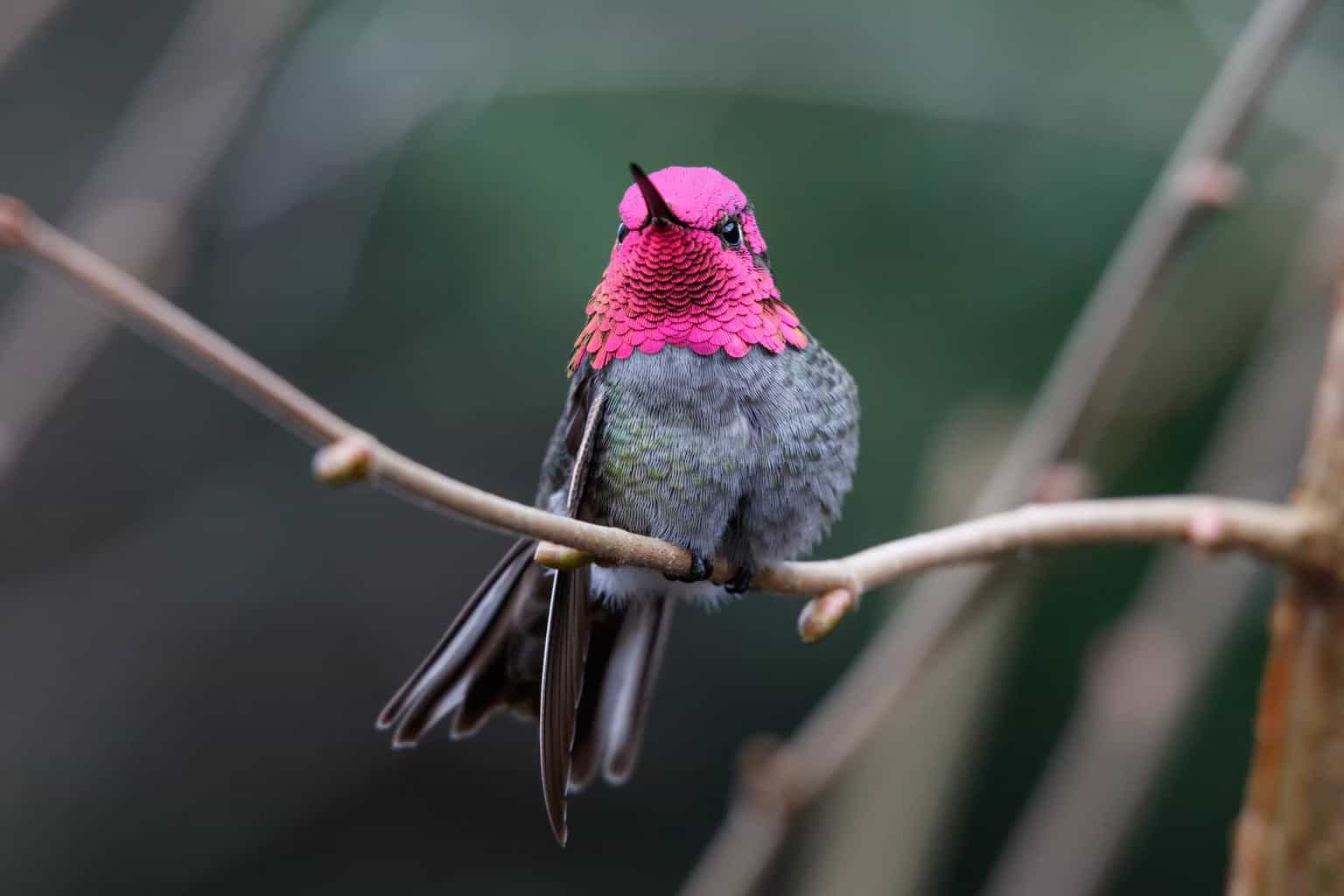
- Scientific Name: Calypte anna
- Length: 3.9 in
- Weight: 0.1-0.2 oz
- Wingspan: 4.7 in
Additional Information:
Unlike the other members of its species; Anna’s hummingbird is a rather plump bird. It has a stunning assortment of metallic colors mostly derived from green. The adult males have extra pink highlights on their necks and heads.
This hummingbird would only take residence where flowers are plentiful, as that’s the only way to find a reliable supply of nectar. You can find it in parks, gardens, eucalyptus groves, and in coastal scrub.
American Purple Gallinule
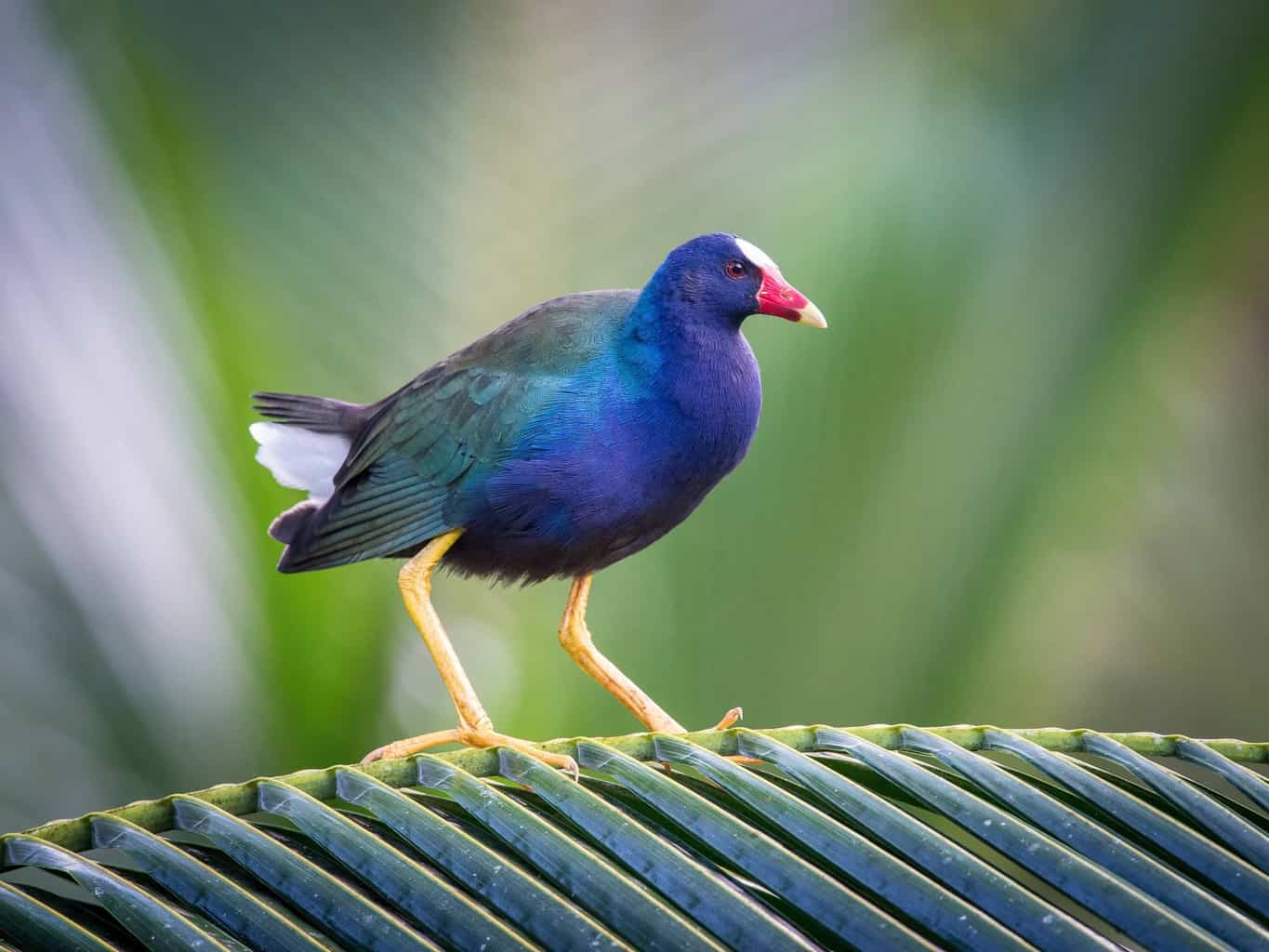
- Scientific Name: Porphyrio martinica
- Length: 13.0-14.6 in
- Weight: 7.2-10.3 oz
- Wingspan: 21.6-22.1 in
Additional Information:
The American Purple Gallinule is a stocky marsh bird, and as the name implies, it’s mostly purple. This bird is also characterized by having long yellow legs and a multicolored bill. It’s hard to miss the blue, red, and yellow colors on that long bill.
This bird is an omnivore that would eat an aquatic invertebrate, catch a hopping frog, or dig out a tuber. It’s surprisingly agile on its legs and easily walks through the floating vegetation in subtropical wetlands.
Conclusion
Louisiana is a State that’s teaming with wildlife. In addition to the vast coastlines, marshes, prairies, and riverbed grasslands, there are various national parks and preservation sites that you can visit and where you can enjoy protected nature.
There are also many more birds that you might want to check out during your visit. The hawks and owls are definitely worth exploring.

